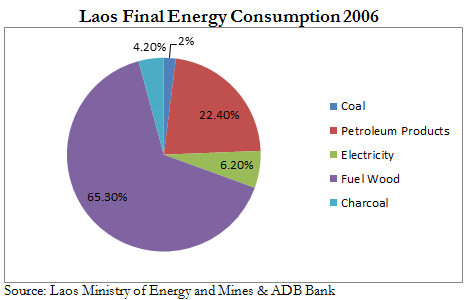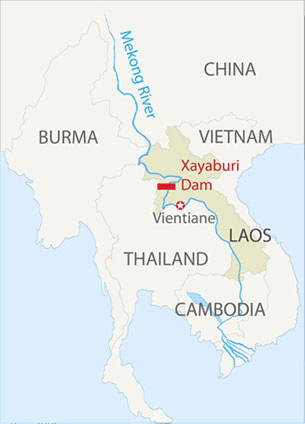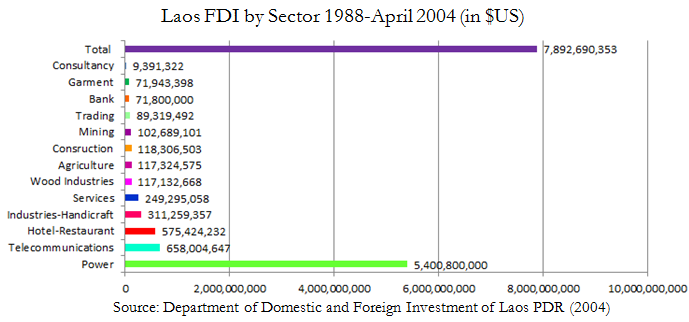Laos Overlooks the Impact of Social and Environmental Damages in Moving Forward with the Xayaburi Dam
A classic dilemma for emerging economies in today’s world is the choice between economic development and preserving the country’s socio-cultural integrity. This two part article will analyze the decisions behind Laos and Myanmar’s decisions for each country’s respective hydroelectric projects, where the former has chosen economic development and the latter has chosen to preserve their socio-cultural integrity.
Laos: Why Hydropower?
Laos is a landlocked country in Southeast Asia, that has traditionally been isolated due to its lack of sea access. This disadvantaged geographical situation has caused Laos’ GDP to depend greatly on its neighbors over the years, where in 2010 Laos’ GDP per capita was $1,208 USD due to the countries growing trade with Thailand, its largest trade partner. In terms of GDP (purchasing power parity), Laos is ranked the 129th nation in the world- illustrating the country’s poverty and need for economic development.
Laos’ energy mix reflects the country’s poverty as illustrated on the disproportionate reliance on biomass fuels like firewood. As a result, the Laotian government wishes to grow economically by setting an electrification goal of 90% by 2020. This goal will most likely be met by coal and hydropower, the two fuel sources Laos’ has in abundance domestically.
The Xayaburi Dam: An Additional 4.5% to Laos’ Installed Hydroelectric Power Capacity
Laos’ economic situation and lack of electricity has pushed the country toward developing its hydropower, as the country’s rivers are estimated to have the capacity to produce about 28,000mW of electricity. As part of this overall plan, the Laotian government initiated the Xayaburi Dam project in order to harness power from the Lower Mekong River. It is to be the first dam project in this region, and has the ability to affect the lives and economy of downstream Mekong River countries like Myanmar, Thailand, Cambodia, and Vietnam. But more importantly, the project can help Laos reach its economic, development, and electrification goals as the Xayaburi dam is expected to have the capacity to produce 1,260 mW of power when it is completed. This will increase Laos’ current installed hydroelectric power capacity by 4.5%, from 6.6% to 11.1%.
The Social-Environmental Controversy
Although the Xayaburi Dam has the potential to improve the lives of Laotians, the project still faces tremendous objection and protests from Laos’ neighbors, conservationists, and climate change experts. As with any hydroelectric project, the concern surrounding the effect the dam will have on the Mekong River’s people and diversity is real. As a result, Laos (a signer of the 1995 Mekong River Commission) has had to answer to these concerns by conducting an Environmental Impact Assessment to adequately weigh the Xayaburi’s economic benefits with the social-environmental costs.
However, controversy has instead ensued over this impact study due to charges that Laos and its business partners used sub-standard measurements. For instance, a WWF Review asserts that Laos’ study utilized only a “light sampling” that “captured 1/3 of biodiversity” found in the Mekong River. International Rivers also criticized that the evaluation was unable to capture the impact of “sediment flows [and] dam safety.” What’s worse, is that their proposed technologies and designs for fish migration has not been previously tested on the Mekong River’s target fish species. In addition, there may be a conflict of interest as the Swiss-firm hired for the Environmental Impact Study (Poyry Energy) is known to be a business partner of Thai company Ch. Karnchang (Xayaburi Dam’s main investor).
In other in-depth impact studies, the social and environmental costs are much worse. For instance, the Xayaburi Dam is found to potentially block the migration of target fish which may lead to the extinction of 41 species in the future. This could also lead to the starvation or loss of fisheries and livelihood for some 200,000 people downstream. In terms of direct impact, the dam will displace an additional 2,100 people from about 40 villages all in the nearby area.
It’s All About the Money & Politics
Despite the telling signs of long-term damage to the Mekong River and Laos’ agreement to suspend the project in April, the Laotian government has recently went ahead with the construction of the Xayaburi dam. But why?
1) Increases Foreign Direct Investment in Laos
The most important reason for choosing to construct the dam, I believe, is the project’s potential to attract a lot of foreign direct investment (FDI) and revenue. If built, the Xayaburi dam will be the first in a series of 10 other dams on the Mekong River. This dam will be the start of Laos’ electricity export industry, allowing the country to exponentially grow its domestic GDP in the next few decades.
For instance, the Xayaburi dam project is estimated to take 7.5 years to construct and an investment need of 3 Billion USD. So far, 90% of this investment fund has already been met by one Thai company- CH Karnchang. There is investment interest from four other Thai Banks as well (Kasikorn Bank, Bangkok Bank, Krung Thai Bank, and Siam Commercial Bank), with more than half of Laos’ current FDI going to hydroelectric projects.
In addition, Laos’ neighbors will provide the landlocked country with demand as illustrated by Thailand’s electricity company, EGAT. EGAT has already signed to purchase 95% of the Xayaburi Dam’s electricity output in 2010 and will be one of the key purchasers of Laotian energy in the future. The region’s growing energy demand will be a tremendous asset to Laos in the future, as it prepares to harness the country’s estimated 28,000 mW of hydroelectric power.
2) Thailand’s Political Influence
A second factor I believe has highly influenced the resumption of the Xayaburi Dam project is Thailand’s interests and influences on Laos. At the moment, Thailand is Laos’ largest trading partner and political ally. It has for years helped Laos develop its country by building roads to ease the landlocked country’s transportation problems.
In recent years, Thailand has also been aware of its energy needs and its over-dependence on natural gas in the power generation industry (66.2% in 2007). This has forced Thailand to look for other sources, making Laotian hydroelectric power ideal for the coming years. As a result, we see Thailand investing heavily in Laos as they hope to gain 7,000 mW from Laos’ total of 28,000 mW of power in the future.
3) Laos Fighting Back
The last reason I believe Laos is choosing to disregard its regional agreements to suspend the construction of the Xayaburi Dam is based on the country’s wish to fight back. As a small and landlocked country, Laos has had to deal with its fair share of bullies in the region. It has also had to rely heavily on its neighbors to export and import goods, making it hard for the Laotian government to truly assert its sovereignty.
But with hydroelectric power, Laos does not need to governed by others. Making the Xayaburi Dam as an example, Laos will be able to increase the livelihood of its citizens, while reasserting control over its territory and economic development. The total disregard of regional agreements and international criticism illustrates Laos’ rebellion, demonstrating the start of the country’s power struggle over FDI, foreign experts, and dominance in the sales of electricity in Southeast Asia.
Stay Tuned
Laos’ decision is not unusual given the country’s need to electrify, need to increase investment, and need for Thailand’s trade. However, this does not always have to be the case. Stay tuned as I analyze why Myanmar has sought to suspend the Myitsone Dam next week despite China’s influence and Myanmar’s need to develop.
Click here for more information on Southeast Asia’s disputes in the South China Sea.
Click here to understand How Dependent Asia’s Top 4 Economies are on Foreign Oil.








An excellent update of an issue that will no doubt dominate dialogue on Laos in this decade. It is I think worth pointing out that in spite of the very significant increase in electricity generation and distribution to parts of Laos on or near the rudimentary grid that has taken place in the past decade, some 50% of Lao live without any electricity supply. This is understandable given the geography and history of Laos and the authorities are making real attempts at changes that benefit the people as well as fill national coffers. It is hoped that the Xainyabouli dam, if it gets built, will be designed to reduce the impact on other uses of the Mekong, including river tourism, and serve not only Thai industry but the population of Xainyabouli, most of whom currently live in the dark. It will of course increase reliance on Thailand — the traditional enemy — which last invaded Laos in 1987…in Xainyabouli (Sayabouri)…to be ignominiously defeated by the Lao army. 7.5 years could be a long time in Lao-Thai politics.